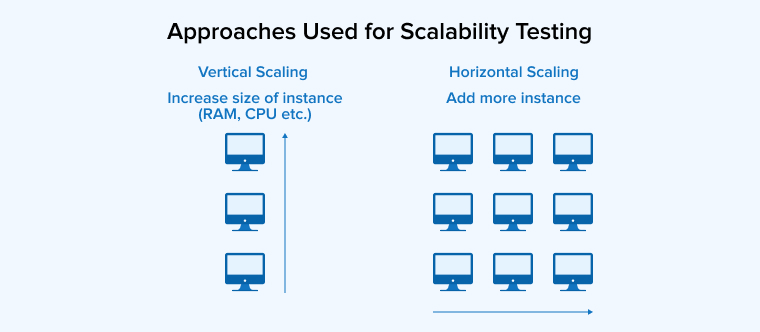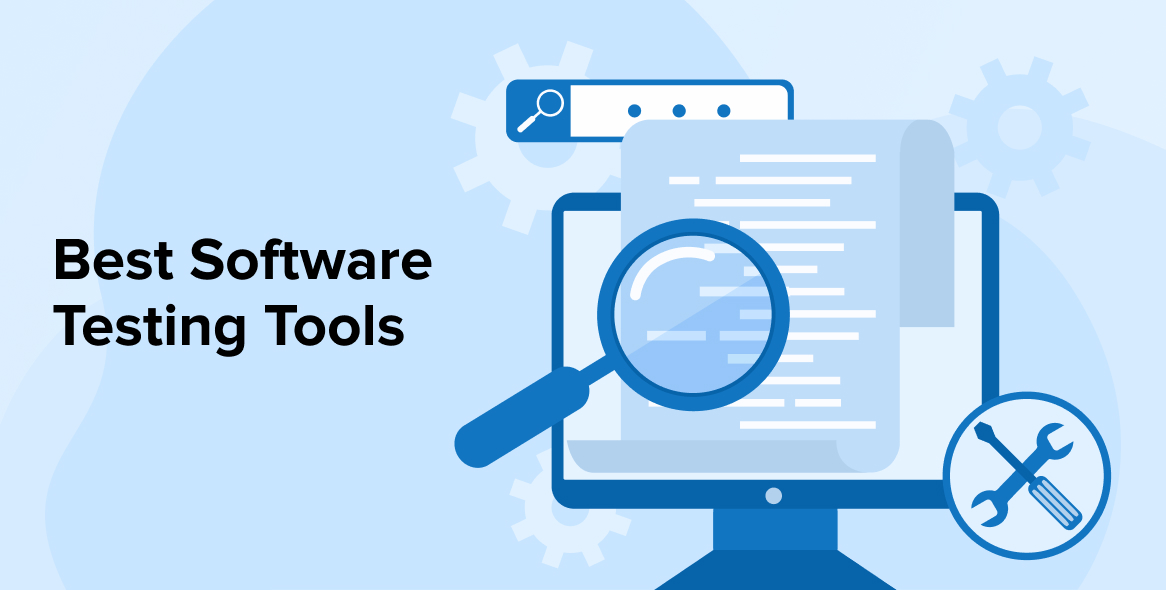
Developers often meet unexpected issues in their apps that do not arise during the development phase, but create an issue later. This occurs when software is not accurately tested for real-world usage. Hence, your software testing company to test your application before the launch and periodically thereafter. By conducting these tests, development teams can identify any slowdowns, improve performance, guarantee a pleasant user experience, and more.
This blog post explores scalability testing, discussing its pros and cons and best practices for a successful outcome.
1. What Is Scalability Testing?
Scalability Testing is a type of non-functional testing that assesses the ability of a software application, system, network, or process ability to manage varying amounts of user requests processed and performance factors. The task can be executed at the hardware, software, or database level.
Scalability testing, also known as performance testing, assesses how a system performs under difficult conditions, such as heavy loads or new deployments in expanded environments.
Scalability testing is an important part of software engineering since it determines when an application stops scaling and helps understand why it stopped working.
2. Why Perform Scalability Testing?
Before releasing software, scalability testing is essential. Here are many reasons why scalability testing is important:
- It helps find out why the app or program stops scaling by studying how it handles a rise in workload and when it reaches its limit.
- Assists in defining the user limit associated with an application or software package.
- You can find out how well your software handles increasing loads by conducting scalability tests.
- Establish the maximum number of users that can access the web app.
- Assess the reliability of the server, the end-user experience, and the durability of the server side.
3. Advantages of Scalability Testing
The following are some of the advantages of including scalability tests in software testing and development:
- To improve delivery outcomes, it is helpful to assess and analyze the end-user experience under various load situations. This allows for proactive problem-solving.
- Before deploying modifications to the production environment, it is helpful to find different performance-related issues in an application during testing.
- You can use it to find out how the web app is performing in terms of various metrics like response time, network use, etc.
- By conducting scalability tests, you can better organize the various monitoring and tracking tools available to you.
- Creates a solid foundation for uninterrupted operations by guaranteeing that programs will continue to function reliably even when demand is at its highest.
- By conducting thorough scalability tests to assess an application’s overall performance, you can save a lot of time, energy, and resources.
4. Disadvantages of Scalability Testing
There are benefits to scalability testing, but there are also some drawbacks:
- Extended development delays caused by thorough scalability testing might impact project delivery speed.
- There can be variations in the desired results as the test environment is not necessarily an exact representation of the production environment that clients utilize.
- Demands huge resources, such as technology, software, and staff, and demands meticulous budget control, which presents difficulties for firms with limited resources.
- Adding complexity and requiring skilled employees, demands an in-depth familiarity with application design, user behavior, and any issues that arise.
- If you spend time on scalability tests and addressing various issues, you can delay project timelines.
- The scalability tests fail to detect the unresolved functional issues.
- When the test window is very small, it becomes significantly more difficult to execute all of the scalability tests specified in the testing scope.
5. Scalability Testing Attributes
The performance metrics that will serve as the foundation for this testing are defined by the scalability test attributes. When doing scalability tests, it is important to keep in mind the following attributes.
5.1 Response Time:
Tests should prioritize response time since it contributes to a better user experience. When your system is under significant pressure, this test point will show you the time taken to process user requests. The results of this test might help you improve the user experience by revealing which resources are slowing things down.
5.2 Throughput:
The number of requests an application can process in one unit of time defines its throughput. The difference between web and database applications is that the first uses the number of user requests handled per unit time as its metric, while the second uses the number of queries performed per unit time.
5.3 CPU Usage:
CPU Usage is a metric that quantifies the amount of program used to complete a task. People normally use MegaHertz to measure CPU usage. In the ideal situation, we aim for low CPU utilization and highly optimized application code. Many businesses utilize standard programming approaches to achieve the goal of minimizing CPU utilization.
5.4 Memory Usage:
Memory usage refers to calculating how much memory an application needs to execute a task. The basic unit of measurement is the byte.
5.5 Network Usage:
It is essential to evaluate network usage as a key metric. We take into account the bandwidth required to complete a certain task. To achieve the best outcomes from an application, you should keep it minimal. Reducing network usage is possible with the use of various congestion methods.
6. Prerequisites for Scalability Testing
Before doing scalability testing, it is crucial to take into account the following essential requirements.
- Load Distribution Capability: It refers to the capacity of a system or device. Assess if the load test instrument can draw load from several machines and be managed from a central location.
- Operating system: Evaluate the operating systems utilized by the load-generating agents and the load test master.
- Processor requirements: Determine the specific CPU requirements for the load test master and virtual users used in conducting scalability testing.
- Memory: Determine the required amount of RAM for the virtual user agent and load test master.
7. Steps of Scalability Testing
It is crucial to have a thorough understanding of how to effectively conduct scalability testing to get the desired results. To get started, you simply follow the instructions below.
7.1. Outline a Procedure for Conducting a Scalability Test
The initial phase involves establishing a framework for conducting scalability tests. After the procedure is completed and authorized by the project stakeholders, it can then be replicated to document the testing observations throughout the application’s life cycle.
7.2. Establish Criteria to Assess the Scalability
After establishing the process, the focus shifts to identifying the appropriate criteria for defining the necessary scaling conditions.
7.3. Compile a List of Software Tools
To conduct the intended scalability tests, all you need to do is define the appropriate software tools. You will compile a list of the necessary software tools for conducting or performing the load test scenarios.
7.4. Set up the Test Environment
This step involves the establishment and configuration of the testing environment to ensure a thorough understanding of the environments included in the scalability tests. Additionally, you must configure the necessary hardware for executing scalability tests.
It is essential to choose a test environment that accurately replicates the planned production environment. By utilizing this, you will be able to conduct tests in authentic situations and guarantee consistent accuracy of the results. Thorough and error-free testing guarantees that no major problems are overlooked during the production phase, enabling your software program to provide an optimal user experience.
8. Approaches Used for Scalability Testing
When it comes to scalability testing, there are two main ways to go about it.

8.1 Horizontal Scaling
In this method, the demand for each machine or resource is reduced as more and more physical machines and resources are added. Rather than enhancing the current capacity, this method focuses on expanding the number of nodes. Both the existing and newly added resources contribute to the workload. Another name for this is “scaling out,” which refers to expanding operations by adding more and more resources. Companies like Google, Facebook, Amazon, etc., that handle massive projects or apps often employ this kind of scalability. When data is split up, the workload is distributed among several nodes, which improves performance over time.
8.2 Vertical Scaling
The server’s processing power, random access memory (RAM), and disk capacity can be increased by vertical scaling. Increasing the number of CPUs in a single server is one example of vertical scaling. As the demand for the system increases, its performance tends to decline; yet, to keep the system efficient, vertical scaling is used. Small applications that can benefit from increasing the capacity and size (scale) of already-used resources to improve load performance often utilize vertical scaling. As part of vertical scaling, data is stored centrally on a single node and distributed over several CPUs and memory via multi-node.
Here is what Nikki Siapno tweeted about Horizontal Scaling and Vertical Scaling
Horizontal vs Vertical Scaling — which one should you pick?
— Nikki Siapno (@NikkiSiapno) April 13, 2023
🔹 Horizontal scaling: Add more servers or nodes to the system.
🔹 Vertical scaling: Add resources, such as memory or CPU, to an existing server or node.
How do you choose which scaling method to use?
🌟 Horizontal… pic.twitter.com/oRJVGgxGzZ
9. Tools for Scalability Testing
Many widely used frameworks and tools assess software scalability. Examples include:
9.1 Apache JMeter:
Apache JMeter is a free and open-source tool that works with Java to test the scalability and performance of web apps, databases, and networks. It also helps with distributed testing.
9.2 LoadRunner:
One commercial tool for reviewing programs and structures under load, stress, and endurance is LoadRunner. It can model various network scenarios, generate thorough performance statistics, and execute realistic and scalable test scenarios.
9.3 Gatling:
Built-in Scala, Gatling is an open-source load testing tool that offers real-time data for performance monitoring, is scalable, and runs asynchronously.
9.4 Locust:
You can use Locust, an open-source tool, to test web applications and services for load, stress, and endurance. It can model actual user behavior, execute scalable and distributed test cases, and provide real-time statistics and performance feedback.
10. Best Practices for Scalability Testing
To get the most out of scalability testing, you should always follow industry standards.
- Before implementing any changes to the system design, make sure to start scalability testing early on to find and fix any possible concerns.
- Creating a list of every potential user situation is highly recommended. Upon finalizing the product specifications, you can make any necessary modifications.
- Using the above settings and users, create a test load system.
- During testing, keep an eye on critical performance indicators to identify performance problems and obstacles straight away.
- Make sure that the development and testing teams work together to fix bugs efficiently and achieve performance targets.
- Keep an eye on the parts that don’t work and change them as needed.
- Continue to refine and enhance the current tests until you achieve your goal.
11. Conclusion
Scalability testing is an important part of software quality assurance to ensure the smooth running of day-to-day operations. Most software development teams include this step in their testing procedures to ensure the software stands up to fluctuations in user activity, data volume, and transaction counts.
Implementing scalability testing is crucial to guarantee that performance metrics and software quality remain unaffected by changes, which is especially critical given the growing importance of both app’s time-to-market and quality.
Frequently Asked Questions (FAQs)
How do you assess the Scalability of Software?
To assess software scalability, analysts use system performance metrics such as response time, throughput, and resource usage. These metrics are beneficial when managing increasing amounts of data or users.
Who Performs Scalability Testing?
Scalability testing is mostly performed by software quality analysts.
What type of Testing is Scalability Testing?
Scalability testing, also called performance testing, aims to assess how a system performs when subjected to difficult conditions, such as heavy loads or new deployments to expanded environments.






Comments
Leave a message...